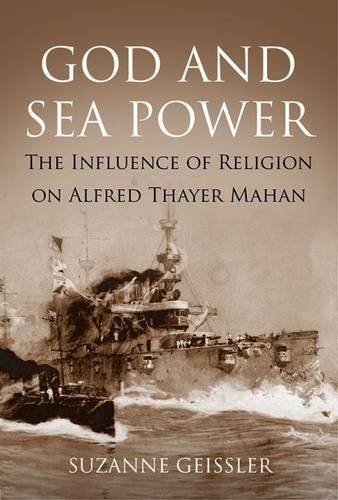God and Sea Power: The Influence of Religion on Alfred Thayer Mahan
Suzanne Geissler
 As described by Suzanne Geissler, Alfred Thayer Mahan lived a life devoted to God and the United States’ military. Using Mahan’s letters and a journal from his service in the navy, Geissler seeks to demonstrate the influence that Christianity played in his career, providing a detailed account of the events that influenced Mahan to be a devout Christian, renowned leader, and respected writer. As a historian and theologian, Geissler tackles this biography from a less secular point of view than previous authors, critiquing previous biographies of Mahan and providing further evidence of the influence of God in his life. Her goal is to provide an understanding on Mahan’s religious faith, its developed, its influence on his thinking, and his role within the Episcopal Church.
As described by Suzanne Geissler, Alfred Thayer Mahan lived a life devoted to God and the United States’ military. Using Mahan’s letters and a journal from his service in the navy, Geissler seeks to demonstrate the influence that Christianity played in his career, providing a detailed account of the events that influenced Mahan to be a devout Christian, renowned leader, and respected writer. As a historian and theologian, Geissler tackles this biography from a less secular point of view than previous authors, critiquing previous biographies of Mahan and providing further evidence of the influence of God in his life. Her goal is to provide an understanding on Mahan’s religious faith, its developed, its influence on his thinking, and his role within the Episcopal Church.
Mahan grew up in an environment equally influenced by God and country. His father, Dennis Hart Mahan, was a graduate of West Point, a member of the Corps of Engineers, and later in life an advocate for military scholarship. Dennis Mahan was a devoted Episcopalian his entire life. Mahan’s uncle, Milo Mahan, was not only a staunch Christian but an ordained deacon and priest. Unlike his brother, Milo Mahan devoted himself to the church, serving as a professor of ecclesiastical history for many years. Clearly, Mahan's forefathers played an important role in the sculpting of his interests.
Mahan and his five siblings roamed the grounds of West Point as children, maintaining strict adherence to the Sabbath. Both he and his younger brothers later served in the military. As a young man, Mahan showed interest in God and in firepower. He spent his teenage years at St. James, an Episcopal boarding school in Maryland. Later, he attended school at Columbia College in New York where he became close with his religious uncle, Milo. In autumn of 1856, Mahan entered the Naval Academy and began his journey into naval history.
Geissler carefully analyses his personal writings alongside current events, spending significant time defending Mahan’s personal righteousness. Mahan appears to be a man simply struggling with his spirituality during political and military upheaval, something Robert Seager II apparently addresses with mockery and sarcasm in his biography of Mahan. At one point in Seager’s work, he suggests that Mahan was an anti-abolitionist. According to Geissler, Mahan had not developed a definitive view on slavery during the Civil War, but did know that it had to end. Despite negative views on Mahan’s personal life, none can deny the importance his writing had on the study of naval history. Mahan’s most respected contribution to the military, The Influence of Sea Power on History, 1660-1783, continues to inspire a hundred years later.
For readers interested in military biographies, I strongly recommend this book. Geissler provides a new perspective into the life of a very complex man whose work continues to impact our country's navy. Her account clearly outlines the influences of religion in the life of Alfred Thayer Mahan and challenges authors who disagree with Geissler’s viewpoint.
- Annapolis: Naval Institute Press, 2015
- 6-1/2” x 9-1/2”, hardcover, xiii + 264 pages
- Photographs, notes, bibliography, index. $29.95
- ISBN: 9781612518435
Reviewed by Samantha Bernard, East Carolina University
